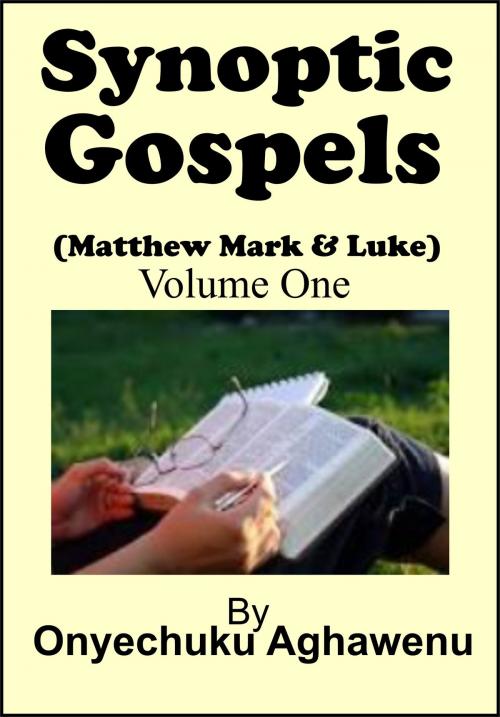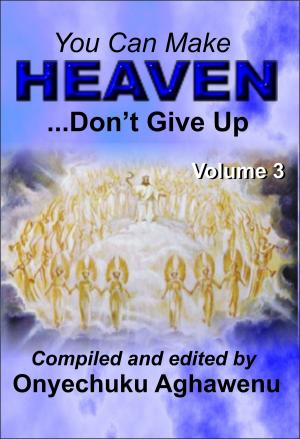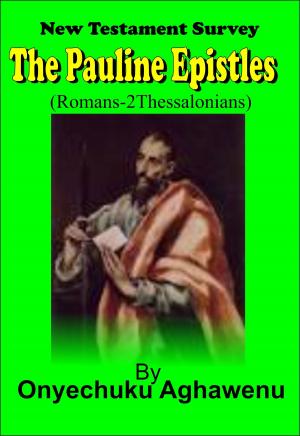Synoptic Gospels (Matthew Mark & Luke) Volume One
Nonfiction, Religion & Spirituality, Bible & Bible Studies| Author: | Onyechuku Aghawenu Ph.D | ISBN: | 9781370795215 |
| Publisher: | Mongraphics Ltd | Publication: | August 9, 2017 |
| Imprint: | Smashwords Edition | Language: | English |
| Author: | Onyechuku Aghawenu Ph.D |
| ISBN: | 9781370795215 |
| Publisher: | Mongraphics Ltd |
| Publication: | August 9, 2017 |
| Imprint: | Smashwords Edition |
| Language: | English |
The Synoptic Gospels are the first three books of the New Testament, Matthew, Mark, and Luke. These three books plus John are called the “Gospels” because they chronicle the good news of Jesus’ life, death, and resurrection—the basis of our salvation. Synoptic, in Greek, means "seeing or viewing together," and by that definition, Matthew, Mark, and Luke cover much the same subject matter and treat it in similar ways. J.J. Griesbach, a German Bible scholar, created his Synopsis in 1776, putting the texts of the first three Gospels side by side so they could be compared. He is credited with coining the term "Synoptic Gospels." The Gospel of Matthew was written by Matthew the apostle, one of the twelve commissioned by Jesus. The Gospel of Mark was written by John Mark, a close associate of the apostle Peter. The Gospel of Luke was written by Luke the physician, a friend and travelling companion of the apostle Paul. Matthew, Mark, and Luke cover many of the same events in Jesus’ life—most of them from Jesus’ ministry in Galilee—in much the same order. Nearly 90 percent of Mark’s content is found in Matthew, and about 50 percent of Mark appears in Luke. All of the parables of Christ are found in the Synoptic (the Gospel of John contains no parables). Matthew, Mark, and Luke cover many of the same events in Jesus’ life—most of them from Jesus’ ministry in Galilee—in much the same order. Nearly 90 percent of Mark’s content is found in Matthew, and about 50 percent of Mark appears in Luke. All of the parables of Christ are found in the Synoptic (the Gospel of John contains no parables).
The Synoptic Gospels are the first three books of the New Testament, Matthew, Mark, and Luke. These three books plus John are called the “Gospels” because they chronicle the good news of Jesus’ life, death, and resurrection—the basis of our salvation. Synoptic, in Greek, means "seeing or viewing together," and by that definition, Matthew, Mark, and Luke cover much the same subject matter and treat it in similar ways. J.J. Griesbach, a German Bible scholar, created his Synopsis in 1776, putting the texts of the first three Gospels side by side so they could be compared. He is credited with coining the term "Synoptic Gospels." The Gospel of Matthew was written by Matthew the apostle, one of the twelve commissioned by Jesus. The Gospel of Mark was written by John Mark, a close associate of the apostle Peter. The Gospel of Luke was written by Luke the physician, a friend and travelling companion of the apostle Paul. Matthew, Mark, and Luke cover many of the same events in Jesus’ life—most of them from Jesus’ ministry in Galilee—in much the same order. Nearly 90 percent of Mark’s content is found in Matthew, and about 50 percent of Mark appears in Luke. All of the parables of Christ are found in the Synoptic (the Gospel of John contains no parables). Matthew, Mark, and Luke cover many of the same events in Jesus’ life—most of them from Jesus’ ministry in Galilee—in much the same order. Nearly 90 percent of Mark’s content is found in Matthew, and about 50 percent of Mark appears in Luke. All of the parables of Christ are found in the Synoptic (the Gospel of John contains no parables).















